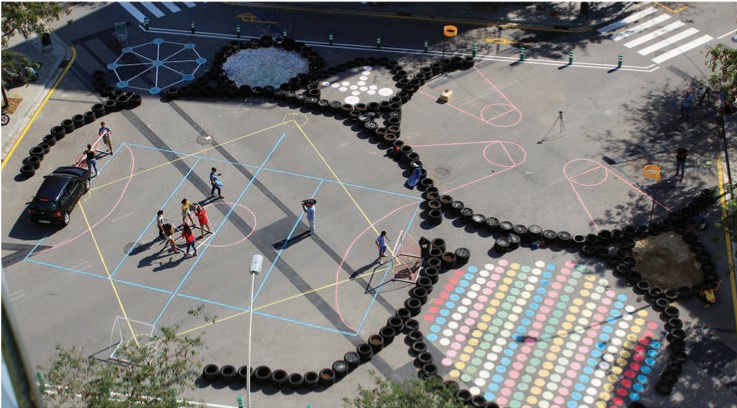DISCOVER YOUR LOCAL BICYCLING COMMUNITY
Find local advocacy groups, bike shops, instructors, clubs, classes and more!
Shared Spaces, Complete Streets, and Safety (book excerpt)
We are happy to be able to share this excerpt from Beyond Mobility: Planning Cities for People and Places by Robert Cervero, Erick Guerra and Stefan Al, published by Island Press. The publisher has provided a 25% discount code with us for anyone who would like to purchase the entire print or e-book. To use the discount code, go to https://islandpress.org/books/beyond-mobility and use the promo code BIKELEAGUE.
In the 1980s, traffic engineer Hans Monderman conducted an experiment in Oudehaske, the Netherlands. He removed all road signs, signals, and road markings and made all pedestrians, bikers, and cars share roads and squares equally, creating a “shared space” (figure 2-1). As a result, all travelers paid greater attention to each other equally to keep everyone safe. Drivers were found to have reduced their speed by 40 percent because of this increase in perceived risk. Monderman’s trial was so successful that other towns including some in Denmark, Sweden, and Germany have taken similar measures to reduce the number of traffic accidents.

Figure 2-1. An intersection in Drachten, a town in the north of the Netherlands based on Hans Monderman’s idea of shared spaces. There are no curbs, lanes, or traffic signs, although pedestrians do have some designated crossing areas. (Source: Fietsberaad.)
Shared spaces epitomize how balancing mobility and place-making can benefit com- munities. The experiment reestablished interpersonal awareness between all road users and reclaimed streets for pedestrians, allowing them to move and interact with another in new ways. By deemphasizing vehicle throughput, curbless streets become destinations. With some modifications, Monderman’s concept of shared space can improve safety and sociability in larger cities as well.
One such example may be Barcelona, which is gradually creating “superblocks” out of multiple blocks in the city’s Eixample district. Each of the superblocks consists of nine existing blocks of the city grid, excluding drivers other than residents and business own- ers from the local roads (figure 2-2). All other traffic, including cars, buses, and scooters, is pushed to the perimeter of the new superblock. As a result, Barcelona has more green space, fewer road accidents, less air pollution and noise, and better overall public health. (Air pollution in Barcelona causes more than 3,500 premature deaths per year.)

Figure 2-2. A transformed intersection in Poble Nou, Barcelona, with playing areas for children where there used to be cars. (Source: Confederación de Talleres de Proyectos de Arquitectura.)
Traffic calming and pedestrian safety measures can take other forms as well. Larger block sizes are known to promote faster automobile speeds, and shorter blocks with more stops will force drivers to move slower, thus reducing the severity of any collisions. Shorter blocks also promote walking, as Jane Jacobs mandated: “Streets and opportunities to turn corners must be frequent.”
Other traffic calming measures include speed bumps, speed cushions, raised intersections and crossings, traffic circles, chicanes, and turns in the road, all of which force cars to slow down even when they are not turning a corner. Implementing tolls on certain roads can also significantly reduce the number of cars in those areas. Smaller roads with fewer lanes, such as reducing a four-lane road to a three-lane road, could force cars to be more aware of each other and slow down. A worldwide study including Japan, Australia, and Europe showed how traffic calming is a promising intervention for reducing traffic injuries and deaths. All of the strategies included in this study included physical elements that could contribute to place-making, such as
- Vertical and horizontal shifts in traffic (e.g., road humps, mini-roundabouts, road narrowing)
- Optical measures (road surface treatment including color or texture), reduced horizontal visibility (shortened sightlines)
- Audible measures (rumble areas, jiggle bars)
- Redistribution of traffic (e.g., permanent or temporary blocking of road)
- Changes to road environment (increased vegetation along road, street furniture)
- Reduced speed limit zones where speeds are physically limited by traffic calming measures
There is also promise in converting one-way to two-way streets. A study in Louisville, Kentucky, showed that a conversion not only decreased traffic accidents (as well as traffic flow) but also led to the increase of livability, with reduced crime and increased property values.
Some cities, including Mexico City, Bogotá, San Francisco, Philadelphia, and New York City, have even begun to implement open street programs, where roads are blocked off for several hours to allow people to walk freely, roller skate, or play games in the streets. Instead of focusing on allowing cars to travel as efficiently as possible, neighborhoods should have streets that are designed to make neighborhoods more livable to other users as well. The most comprehensive approach to benefit communities is the “complete streets” concept, a street designed for all users, not just for drivers, but also for bicyclists, transit users, and pedestrians of all ages and abilities.
Pedestrians, including people with wheelchairs, should have sidewalks and plazas that are safe and accessible, to promote walking. Pedestrian priority areas should be well lit, especially at street crossings, and pedestrians should be given longer lines of sight so that they can look out for themselves as they walk. Changing car-oriented streets to “complete streets” requires an institutional shift, including changing operating procedures so that all users are routinely considered when infrastructure improvements go through the planning, designing, building, and operating process.33 (See chapter 8 for more about complete streets and traffic calming.)